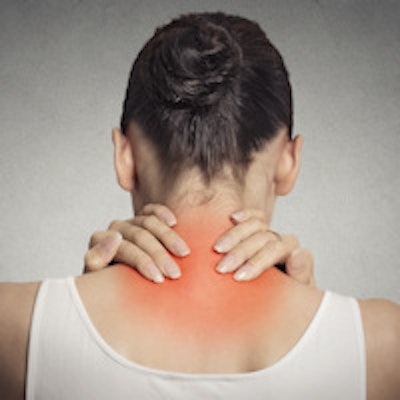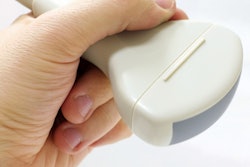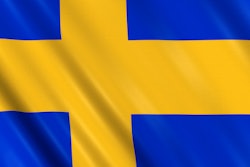
After focusing on back problems in our last Living Pain-Free series for sonographers, it's now time to focus on the shoulders and neck. This new four-part series will explore the causes of pain in these common problem areas, as well as share some practical strategies that can help you get back to living pain-free.
We received a lot of great feedback about our last series on back issues. While many readers had positive comments for us, others wondered why we didn't address the more prevalent sonographer problems of shoulder and neck pain. Don't worry: We'll provide you with a range of movements, stretches, and exercises that can help. In keeping with our philosophy of working the body as a unit, we must emphasize, however, the importance of not relying solely on shoulder movements to relieve shoulder pain or on neck movements to alleviate neck pain.
As long-time readers of our previous articles on AuntMinnie.com may remember, co-author Doug Wuebben is an echocardiographer who had debilitating shoulder pain that nearly forced him out of the profession he loves. While the shoulder pain was the primary symptom, the root causes were issues with his shoulders, neck, upper back, and lower back. His lack of hip mobility was also a contributing factor.
Thanks to exercise, ergonomics, and the proper equipment, Doug was able to overcome his physical problems and get back to scanning and living pain-free. But before we get started on trying to solve your own pain problems, let's quickly review why shoulder and neck issues shouldn't be viewed in isolation.
The neck
The neck is a lot more than just neck bones and a muscular column that keeps the head fixed to the body. The sternocleidomastoid muscles -- the side muscles that originate in the sternum and clavicle and run the length of the neck -- provide strength and stability to the neck. These muscles also give us the appearance of having a strong neck. The lower part of the sternocleidomastoid ties into the inner trapezius and provides muscle stability directly above the clavicle bone.
The sternocleidomastoid helps with all aspects of head movement as well as cervical vertebra flexion, enabling the upper spine to bend and flex. As a result, training these muscles can yield far-reaching benefits.
Another relevant muscle, the trapezius, originates from the occipital bone of the skull and plays a major role in head extension. Training the trapezius ensures complete back development. When not included in a training program, the neck, shoulders, and back will all have problems.
The semispinalis, longissimus, and splenius capitis muscles underlie the trapezius and also assist with head extension. Working these muscles will assist the development of the trapezius muscles and also provide additional support for the neck. Maintaining flexibility and mobility in these muscles will help eliminate neck pain and aching shoulders.
The shoulder
The multidirectional shoulder is the most mobile and versatile of all the joints in the human body. The shoulder, in conjunction with the other parts of the arm, can create a powerful lever to perform a number of tasks such as lifting or prying movements.
The ability of the shoulder to rotate is essential for reaching in different directions, throwing, catching, or shooting actions in a multitude of jobs, activities, and sports. A healthy shoulder can rotate 360° from every position.
The shoulder's ability, wide range of flexibility, and range of motion is made possible by the unique structure of the joint. Virtually every joint in the body brings two or more bones into close, one-on-one contact. The shoulder, however, relies to a much greater degree on connective tissue for its strength as well as its ability to absorb significant force. The downside is that this reliance on connective tissue also leads to the shoulder having the highest risk of soft-tissue injury of any joint.
The skeletal components of the shoulder include the humerus, the long bone of the upper arm that is part of the elbow and shoulder joints; the scapula (shoulder blade), positioned on the posterior (rear) of the shoulder on the upper back; the clavicle (collarbone), aligned between the neck and the outer limit of the shoulder; and the sternum (breastbone), which is not a primary bone in the formation or function of the shoulder joint.
Upper back
The upper back works with the shoulder to assist in certain movements, stability, and support of shoulder function. Although it's important not to look exclusively at certain areas of the back when seeking to live pain-free, we'll focus in this series on the upper back: the thoracic spine up through the neck.
The back is an essential component of how we move and function, whether we twist, rotate, or are propelled forward, backward, upward, or downward. It is a complex structure capable of producing and taking on large forces, as well as flexing and extending through a remarkable range of movement when the back is healthy.
The back consists of the entire posterior, or rear, of the body from the neck to the buttocks. The back and its characteristics are best understood through an appreciation of each of its components. The spine, or backbone, is a bony structure that is divided into four separate regions: the cervical spine, thoracic spine, lumbar spine, and sacral spine.
The cervical spine comprises seven vertebrae referenced as C1 through C7, with C1 at the top of the spine. The cervical spine has three essential skeletal functions:
- It supports the weight of the skull.
- Vertebrae C1 and C2 are the structures responsible for the neck and head being able to turn.
- Vertebrae C6 and C7 permit the flexion and extension of the neck and head.
The thoracic spine is made up of 12 vertebrae (T1 through T12). This structure is capable of very little motion, as it is primarily protective. We won't go any farther down the spinal column in these articles, but we want to make sure you understand the importance of working the body as a total unit, not just individual segments. Stay tuned for our next three articles, which will show you how to achieve pain-free work and play by performing the right moves for your neck, shoulders, and upper back.
Doug Wuebben is a registered echocardiographer and also a consultant, international presenter, and author of e-books in the areas of ergonomics, exercise and pain, and injury correction for sonographers. He has also been published on the topics of telemedicine and achieving lab accreditation.
Mark Roozen is a certified strength and conditioning specialist, a certified personal trainer, and a fellow of the National Strength and Conditioning Association (NSCA). He also consults, presents, writes, and works with groups, teams, and organizations around the world. He has been in the strength, conditioning, and performance field for over 30 years.
You can download a previous collection of Wuebben and Roozen's articles for AuntMinnie.com by clicking here.
Wuebben and Roozen are co-founders of Live Pain Free -- The Right Moves. Email [email protected] or go to coachrozy.com for more information on programs, training, or speaking requests, or if you have any questions or comments.
The comments and observations expressed do not necessarily reflect the opinions of AuntMinnie.com.



















